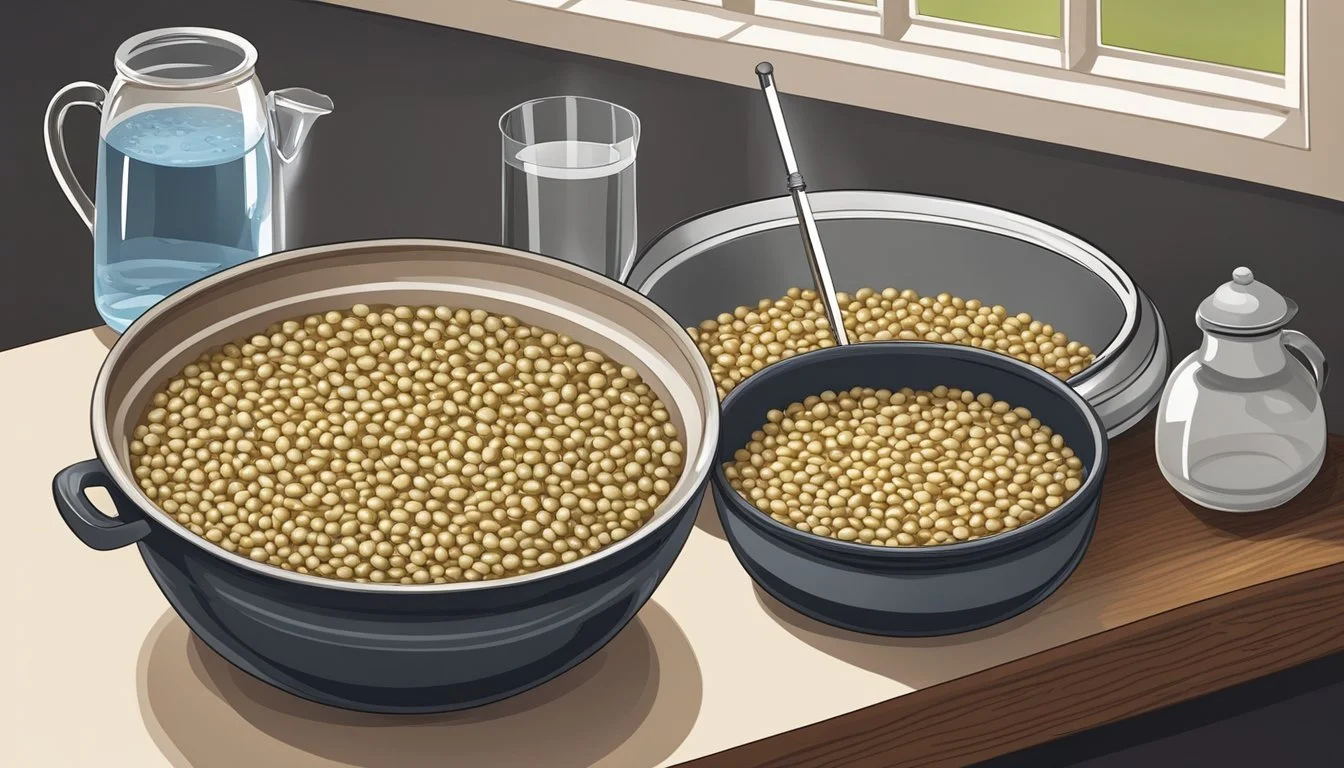How to Ferment Tempeh
A Step-by-Step Guide for Homemade Goodness
Tempeh (What wine goes well with tempeh?) is a traditional soy product originating from Indonesia that has gained popularity worldwide as a high-protein, plant-based alternative to meat. The fermentation process it undergoes not only enhances its flavor and texture but also increases its nutritional value, making it a favorite among health enthusiasts. Made by fermenting cooked soybeans with a starter culture, tempeh boasts a firm texture and a nutty, earthy flavor, which becomes more pronounced with the fermentation time.
To make tempeh, soybeans are soaked, de-hulled, and then cooked. They are then inoculated with a tempeh starter, which contains the specific spores necessary for fermentation. The mixture is then packed into perforated bags or wrapped in banana leaves to allow for the growth of the mycelium, which binds the soybeans into a solid cake. The fermentation is typically carried out at a warm temperature, between 85°F and 90°F, for a period of 24 to 48 hours.
This fermentation process is what sets tempeh apart from other soy products. It enables the development of a unique texture and imbues it with a rich, savory flavor. As a versatile ingredient, tempeh can be incorporated into a variety of dishes, from stir-fries to sandwiches, making it an invaluable addition to the repertoire of vegetarians, vegans, and anyone looking to diversify their protein sources in their diet.
Understanding Tempeh
Tempeh is a traditional soy product that is hailed not only for its versatility in vegetarian and vegan cuisine but also for its significant nutritional content. Let's explore what tempeh is and its nutritional profile.
What Is Tempeh
Tempeh is a plant-based protein source that originates from Indonesia, where it has been a staple for centuries. It is created through a controlled fermentation process that binds soybeans into a cake form. To produce tempeh, one typically starts with hulled and cooked soybeans. These are then inoculated with a starter culture, most commonly Rhizopus oligosporus. The mixture is then left to ferment for about one to two days at a warm temperature, allowing the mold to create a dense, white mycelium that binds the beans. The result is a firm, flavorful cake, rich in protein and fiber, and can be sliced or chopped to be used in various dishes.
Nutritional Profile
The nutritional profile of tempeh is impressive, making it an excellent choice for those following a plant-based diet as well as anyone looking to incorporate more nutrient-dense foods into their meals.
Protein: Tempeh is a complete protein, meaning it contains all essential amino acids needed by the body.
Fiber: It's a rich source of dietary fiber, which is beneficial for digestive health.
Vitamins and Minerals: Tempeh contains vitamins such as B2 (riboflavin) and B3 (niacin), necessary for energy metabolism, along with minerals like iron and calcium, which are essential for blood health and bone strength, respectively.
Calories: It is relatively low in calories, yet high in satiety due to its high protein and fiber content.
Carbohydrates: Tempeh has a moderate amount of carbohydrates, providing sustained energy without rapid spikes in blood sugar.
Sodium: The fermentation process can add sodium to the product; however, it is generally not high in sodium.
Here is a summarizing table of the nutritional content in a typical serving of tempeh (100 grams or approximately 3.5 ounces):
Nutrient: Calories
Amount: 193 kcal
Nutrient: Protein
Amount: 18.5 g
Nutrient: Carbohydrates
Amount: 9.4 g
Nutrient: Fiber
Amount: 4.8 g
Nutrient: Fat
Amount: 10.8 g
Nutrient: Calcium
Amount: 111 mg
Nutrient: Iron
Amount: 2.7 mg
Nutrient: Sodium
Amount: Varies with brand
Tempeh serves as a nutrient-dense food that supports a variety of dietary preferences, including vegan and vegetarian lifestyles. Its dense texture and ability to absorb flavors make it a versatile ingredient in the kitchen.
Preparation of Soybeans
Proper preparation of soybeans is crucial for successful tempeh fermentation. One must ensure that the beans are well-selected, de-hulled, split, and boiled correctly to provide the ideal substrate for tempeh culture to grow.
Selecting Soybeans
When selecting soybeans for tempeh, it's critical to choose beans that are fresh and of high quality. They should be uniform in size to ensure even cooking and fermentation. Organic, non-GMO soybeans are preferred for their minimal exposure to chemicals.
De-hulling and Splitting
The hulling process involves removing the outer layer of the soybeans. One can de-hull soybeans by first soaking them in water for about 12 hours, which loosens the hulls. After soaking, the hulls can be removed either by hand, for small batches, or with a hulling machine for larger quantities.
Soaking: Place soybeans in a large bowl and cover with water.
Duration: Soak for 12 hours to soften hulls.
Splitting the beans can be done after or during the de-hulling process. Once de-hulled, the soybeans are easier to split, generally accomplished by gentle pressure or mechanical action. This step is essential as it increases the surface area for the spores to colonize.
Boiling and Cooking
Boiling the soybeans is the next stage. Boiling ensures that the beans are cooked and any potential bacteria are killed. The beans must be placed in boiling water and then simmered until they're almost fully cooked but not mushy—usually for 30 to 40 minutes.
Boil: Immerse de-hulled and split soybeans in boiling water.
Simmer: Cook the beans on a medium heat to maintain a gentle simmer.
Creating the Right Environment
To successfully ferment tempeh, one must maintain specific temperature and humidity levels, choose an appropriate fermentation container, and consider air circulation to support the growth of beneficial mold.
Temperature and Humidity
For tempeh fermentation, the temperature range should be consistently between 30-37°C (85-98°F). It's critical to avoid lower temperatures to ensure the mold propagates correctly. Humidity also plays a vital role; tempeh requires a **high humidity ** environment to prevent the beans from drying out during fermentation.
Oven: An oven with a light on can achieve the right temperature, especially if the door is left slightly ajar.
Incubator: A commercial or homemade incubator allows for precise temperature control.
Warm Place: Any spot that maintains the required temperature can serve as a makeshift incubator.
Choosing a Fermentation Container
The container for fermenting tempeh should be shallow and allow for slight airflow. Options include:
Perforated Plastic Bags: Bags with holes poked at intervals allow for exchange of air while maintaining humidity.
Glass or Plastic Containers: Use these with a lid loosely placed on top to allow for some air exchange.
Air Circulation Considerations
Air circulation helps prevent spoilage by keeping condensation at bay and distributing the heat evenly. However, too much air can dry out the tempeh. The key is to achieve a balance. One can manage air flow by:
Adjusting Oven Door: If using an oven, regulate the temperature by opening the door to various degrees.
Perforating Containers: Containers or bags should be perforated to allow minimal but consistent air exchange.
Inoculation Process
In the inoculation process of tempeh fermentation, a tempeh starter which contains mold spores, typically Rhizopus oligosporus or Rhizopus oryzae, is added to cooked and partially dried beans. The addition of vinegar creates an acidic environment favorable for mold growth, which is essential in ensuring the even distribution of spores and successful mycelium development.
Adding Tempeh Starter
The inoculation begins with the addition of a tempeh starter, which carries the necessary mold spores to initiate fermentation. A starter typically includes spores of either Rhizopus oligosporus or Rhizopus oryzae. The quantity of starter should be measured according to the producer's instructions, generally about 1 teaspoon per cup of beans.
Mixing with Vinegar
Once the tempeh starter is added to the beans, vinegar is mixed in. Vinegar, typically at a ratio of about 1 tablespoon for every 2 cups of beans, helps lower the pH of the environment. This step is critical as it creates conditions that favor the growth of the Rhizopus mold while inhibiting unwanted bacteria.
Ensuring Even Distribution of Spores
To ensure a successful fermentation, it is paramount to distribute the tempeh starter and vinegar evenly throughout the bean mixture. Beans need to be coated thoroughly. The mixture is then placed in perforated bags or containers, providing the mold with oxygen necessary for growth. During the incubation, the tempeh should be kept at a temperature between 85°F and 90°F for 24 to 48 hours, depending on the recipe and external conditions, to allow the mycelium to fully colonize the substrate.
Fermentation and Incubation
Fermentation is the pivotal phase in tempeh making where the mycelium begins to bind the beans, and incubation provides the controlled environment for this process. Temperature and pH are critical factors that one must monitor to ensure successful fermentation.
Monitoring Fermentation Process
During incubation, it's essential to maintain a consistent temperature range. Keeping the temperature between 85°F and 90°F is recommended. An oven with a light on or an incubator can be used to generate the necessary warmth. Home cooks should periodically check the temperature using an oven thermometer to prevent overheating, which could kill the tempeh culture.
One should also ensure that the pH level has been adequately lowered prior to incubation. Adding vinegar to the beans before introducing the tempeh starter aids in creating an environment that discourages unwanted bacteria and helps the mycelium to thrive.
Identifying Successful Fermentation
Successful fermentation can be recognized by a few clear signs. One should look for a white cottony mycelium that starts to envelop the beans. This usually begins to appear after 10 to 12 hours of incubation. The beans should eventually be bound into a firm, white cake with a pleasant, nutty aroma. If the mycelium is healthy and spreading evenly, it suggests the fermentation process is progressing well.
Harvesting and Storage
Proper harvesting and storage of tempeh are crucial to maintaining its quality and flavor. This section details how to identify when fermentation is complete and the best practices for storing tempeh, whether homemade or store-bought.
Determining Fermentation Completion
To determine if fermentation is complete, one should look for a white mycelium that covers the soybeans—signifying a successful fermentation. The entire process typically takes 24 to 48 hours at a temperature of around 86°F (30°C). The tempeh should be firm and hold together, with a mild, nutty aroma. If these signs are present, the tempeh is ready for harvest.
Storing Tempeh
Once harvested, tempeh should be stored promptly to preserve freshness and prevent spoilage.
Refrigerator: Place the tempeh in an airtight container or sealed plastic bag. It can be stored in the refrigerator where it will remain fresh for up to one week.
Freezer: For longer storage, tempeh can be wrapped in plastic wrap or placed in a freezer bag. Label with the date and freeze. Properly frozen tempeh can last for several months. When ready to use, thaw in the refrigerator.
By following these steps, one ensures the tempeh retains its texture and flavor, whether it's fermented at home or is store-bought.
Cooking and Usage Tips
Before diving into recipes, one must understand the basics of cooking tempeh effectively. This will ensure that its nutty flavor and unique texture are showcased, whether it's being fried in a pan with oil, or added to sandwiches and salads.
How to Cook Tempeh
Slice or Cube: Tempeh can be cut into thin slices or cubes, depending on the recipe needs.
Preparation: It's often recommended to steam or boil tempeh for about 10 minutes to remove any bitterness and to better absorb flavors.
Pan-Frying: Heat a pan with a thin layer of oil over medium heat. Add tempeh and cook until golden brown, usually 3-5 minutes per side.
Oven Baking: For a healthier option, tempeh can be baked. Preheat the oven to 400 degrees F, arrange tempeh on a lined baking sheet, and bake until crispy.
Marinating: To infuse tempeh with flavor, marinate for at least an hour or overnight before cooking.
Incorporating into Recipes
Sandwiches: After cooking, slices of tempeh can be used as a meat alternative in sandwiches.
Salads: Cube and cook tempeh before adding it to salads for added protein and texture.
Tempeh Recipe Variations: The natural nutty flavor of tempeh complements a variety of seasonings and can adapt to numerous cuisines.
By knowing these fundamental ways to cook tempeh and incorporating it into various dishes, one can enjoy the versatility and benefits it offers in everyday cooking.
Alternative Ingredients and Variations
In the realm of tempeh fermentation, a wide range of legumes and grains can serve as the foundation for crafting personalized versions that cater to different tastes and dietary requirements.
Using Different Legumes and Grains
One can choose a variety of legumes such as chickpeas, black beans, and lentils to create tempeh with distinct flavors and nutritional profiles. Grains like barley and millet may also be incorporated to enhance texture and add their subtle taste notes. These alternatives may require slight adaptations in preparation method, such as altering the cooking time to ensure the legumes and grains are tender yet still retain their integrity for fermentation.
Chickpeas: offering a nuttier flavor, they need thorough cooking before fermentation.
Black Beans: provide a rich, smoky taste and darken the color of the tempeh.
Lentils: can be used whole or split, they ferment quicker due to their size.
Barley and Millet: serve as grain additions for creating a mixed substrate that results in a more varied texture.
Homemade Tempeh Varieties
Diversifying homemade tempeh is achievable by experimenting with the blend of legumes and grains or by adding spices and marinades post-fermentation. Incorporating different beans, such as pinto beans, not only alters the flavor profile but also the nutritional content, presenting an alternative to those who may want to avoid soy or simply seek variation.
Tofu Tempeh: a firmer, denser variety made by including tofu as part of the fermentation base.
Multigrain Tempeh: combining grains like barley or millet with legumes to create a textured and flavorful patty.
By thoughtfully selecting ingredients and experimenting with different combinations, one can produce a wide array of tempeh varieties that tailor to individual taste preferences and dietary needs.
Health Benefits
Tempeh is recognized for its health-boosting properties, especially as a fermented food that caters well to vegetarians seeking a nutritious protein source. It is also appreciated for its contributions to gut health due to its probiotic content.
Probiotic Effects
Tempeh is a valuable source of probiotics, the beneficial bacteria that play a crucial role in maintaining a healthy gut flora. These living microorganisms can aid in balancing the gut ecosystem.
Digestive Health
The fermentation process of tempeh not only produces probiotics but also creates enzymes that facilitate digestion. These enzymes enhance the body's ability to absorb nutrients by breaking down complex proteins into more digestible forms. For individuals, particularly vegetarians, tempeh serves as a potent, enzyme-rich addition that supports overall digestive health.






